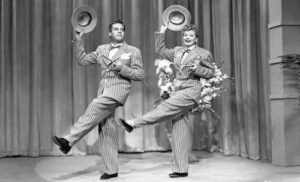
Introduction: A Peek Behind the Curtain
Imagine stepping into a time machine and landing in the 1950s. You’d find a world captivated by the antics of Lucy Ricardo and her bandleader husband, Ricky. But what if you could go beyond the laughter and see how this TV magic was made? The ‘I Love Lucy’ film offers just that—a rare, behind-the-scenes glimpse into the groundbreaking work that shaped television history.
In this article, we’ll dive deep into the world of ‘I Love Lucy,’ exploring its cultural impact, production secrets, and how it became a template for modern sitcoms.
The Birth of a TV Legend
How ‘I Love Lucy’ Came to Be
‘I Love Lucy’ didn’t just happen overnight. It was the brainchild of Lucille Ball and her husband, Desi Arnaz. At a time when women were rarely seen as comedic leads, Lucille broke the mold, proving that a woman could carry a show—and a nation—on her shoulders.
A Risk That Paid Off
The couple insisted on filming in front of a live audience, a risky move that created unparalleled energy. They also pioneered the use of multiple cameras, setting a standard still used in sitcoms today.
The Genius Behind the Comedy
Lucille Ball’s Unmatched Talent
Lucille Ball wasn’t just funny—she was a comedic genius. Her ability to turn everyday situations into laugh-out-loud moments was unparalleled. Remember the iconic chocolate factory scene? That wasn’t just acting; it was art.
Desi Arnaz’s Visionary Leadership
While Lucy shone in front of the camera, Desi was a mastermind behind it. As a producer, he fought for creative control and innovative filming techniques, ensuring the show’s legacy would last for generations.
Breaking Barriers in Television
A Real-Life Couple on Screen
At the time, the idea of a real-life interracial couple starring in a show was unheard of. Lucille and Desi defied societal norms, portraying a loving, relatable marriage that resonated with audiences everywhere.
Tackling Taboo Topics
The show wasn’t afraid to push boundaries. From Lucy’s pregnancy to their portrayal of marital disagreements, ‘I Love Lucy’ tackled issues that were often considered off-limits for television.
Behind-the-Scenes Challenges
The Pressure of Perfection
Creating a show as beloved as ‘I Love Lucy’ came with immense pressure. Lucille and Desi often worked long hours, striving to perfect every detail. The tension sometimes led to personal struggles, but their dedication never wavered.
The Cost of Fame
While the show brought joy to millions, it also took a toll on Lucille and Desi’s marriage. The demands of stardom and production often clashed with their personal lives, eventually leading to their divorce.

The Cultural Impact of ‘I Love Lucy’
A Show That Defined an Era
‘I Love Lucy’ wasn’t just a sitcom; it was a cultural phenomenon. It captured the spirit of the 1950s, offering humor and hope during a time of social and political change.
Inspiring Generations of Comedians
From Carol Burnett to Tina Fey, countless comedians have cited Lucille Ball as a major influence. Her groundbreaking work paved the way for women in comedy and television.
Filming Techniques That Changed TV
The Multi-Camera Setup
Desi Arnaz’s decision to use a multi-camera setup was revolutionary. This technique allowed for dynamic angles and seamless editing, setting a new standard for television production.
Filming in Front of a Live Audience
The live audience added an authentic layer of energy to every scene. Their laughter wasn’t canned—it was real, and it created a connection between the performers and viewers.
Iconic Episodes and Moments
The Chocolate Factory Scene
Who can forget Lucy and Ethel struggling to keep up with a conveyor belt of chocolates? This classic scene epitomized the show’s humor and timing.
Vitameatavegamin Commercial
Lucy’s hilarious attempt at selling a health tonic is another unforgettable moment. Her comedic timing and delivery were nothing short of perfection.
Legacy of ‘I Love Lucy’
A Template for Sitcoms
‘I Love Lucy’ set the blueprint for sitcoms that followed. Its innovative storytelling, character dynamics, and production techniques are still studied and emulated today.
A Show That Stands the Test of Time
Decades later, ‘I Love Lucy’ continues to captivate audiences. Its humor is timeless, proving that great storytelling transcends generations.
Conclusion: Why ‘I Love Lucy’ Still Matters
‘I Love Lucy’ wasn’t just a TV show—it was a revolution. It broke barriers, redefined comedy, and set new standards for television. The film exploring its creation is a treasure trove for fans and newcomers alike, offering a deeper appreciation for the magic behind the laughter.
FAQs
Q1: What made ‘I Love Lucy’ so groundbreaking?
‘I Love Lucy’ revolutionized television with its multi-camera setup, live audience, and innovative storytelling.
Q2: Why did Lucille Ball and Desi Arnaz divorce?
Their demanding work schedules and the pressures of fame contributed to the breakdown of their marriage.
Q3: Are there any modern shows inspired by ‘I Love Lucy’?
Yes, many modern sitcoms, including ‘Friends’ and ‘The Big Bang Theory,’ draw inspiration from the show’s format and humor.
Q4: Where can I watch ‘I Love Lucy’?
‘I Love Lucy’ is available on various streaming platforms like Hulu and Amazon Prime Video.
Q5: What’s the significance of the ‘I Love Lucy’ film?
The film offers a behind-the-scenes look at the making of one of television’s most iconic shows, highlighting its cultural and historical impact.
